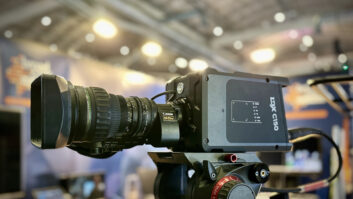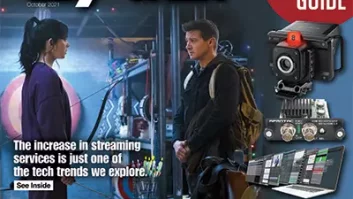
Orad has unveiled a video box production solution and an eight-channel production server. Designed for technical directors/switcher operators, TD Control (pictured) streamlines video box production workflows by consolidating video sources and graphics, delivering a single composited image to the switcher. The technology provides the ability to switch, while on air, from six video sources to six completely different video sources. Users have access to an assortment of video box layouts as well as the ability to create their own video box layouts and store them as a preset for fast recall. The workflow lets users assign relevant video sources to each video box and send it to air. “It is becoming more and more common to see news, sports, and live talk shows split the screen between two, three, four and even six remote guests or talent during a broadcast,” said Avi Sharir, Orad president and CEO. “While such broadcasts are becoming ever more popular, generating this type of visual on air presentation is complicated and involves significant switcher resources and coordination between the technical director, the graphics operator, and other production staff. TD Control greatly simplifies this process by consolidating the various elements — box layout, graphics overlay, video source control — into one easy-to-use solution.” TD Control offers integration with industry-standard switchers, including Sony MV 6000 and 8000 and Grass Valley Kayak. Technical directors/switcher operators can keep their existing workflows or execute the video box presentation from the TD Control touch screen that is placed next to the switcher. The realtime TD Control capabilities let users apply any type of transition or DVE between layouts, or simply cut from one composition to another. Leveraging MOS Protocol, TD Control integrates with industry-standard newsroom computer systems (NRCS). News directors, producers, journalists, and editors can access the TD Control video box templates from within the NRCS; select layout and video source, add graphics detail, and submit for playout. Once submitted, the video box template is automatically transferred to the TD Control rundown and ready for immediate broadcast. TD Control is based on the Orad HDVG 4 video graphics render platform, which offers live video insertion capabilities and realtime 3D graphics and video clip playback. Orad has also revealed its new VJ production server. The Orad VJ architecture supports up to eight input /output channels that can be configured in a variety of combinations. VJ also supports industry-standard codecs, including Panasonic DVCPRO, DVCPRO-HD, and Avid DNxHD, as well as the widely used wrappers QuickTime and MXF. Ingested media are immediately available across the production chain for previewing, editing, and archiving, facilitating fast turnaround production and post production workflows. VJ integrates with industry-standard NLEs, including Avid Media Composer, Apple Final Cut Pro (FCP), Grass Valley Edius, and Adobe Premier Pro. VJ’s edit-while-ingest feature accelerates production and post production processes by enabling the operator to create rough cuts and export clips directly to industry-standard NLEs while ingest is in progress. The user can create as many clips as needed. VJ exports media in the background, continuing with server tasks, such as ingest without interruption. The VJ solution can be implemented as an ingest station, VTR replacement, or for news production, playout, QC and log, and in multi-camera studios where the user can simultaneously record up to eight ISO frame accurate feeds. “VJ’s flexibility lends itself well to a number of production scenarios. For example, VJ can be used as an ingest station and ingest eight channels in parallel from different sources including satellite, VTR tape, cameras, etc. In a news environment, VJ can be used to record and broadcast live feeds to air within a news programme. As a playout server, all of the channel’s recorded content can be sent via the network to VJ and then aired from automation or from VJ’s playlist. The possibilities are nearly endless,” Avi Sharir, Orad president and CEO. The VJ channel configuration includes up to eight channels of support in different configurations, including four bi-directional channels. Video disks can be accessed from the front panel without removing the server from the rack. To optimise server reliability and redundancy, VJ uses a hot swap power supply and runs on a Linux operating system. VJ is available in either 3U box or 1U box, for two-channel configurations. SL4524







